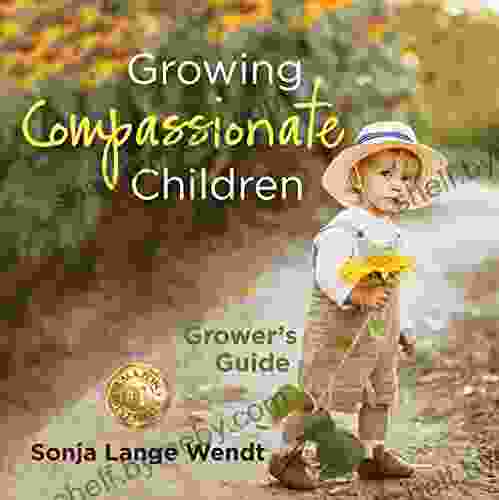Grower Guide Cultivating Compassion In Children

Compassion is a powerful force that can change the world. It is the ability to understand and share the feelings of another person, and to act to help them. Compassion is not something that children are born with, but it is something that can be learned and cultivated.
4.8 out of 5
| Language | : | English |
| File size | : | 6668 KB |
| Text-to-Speech | : | Enabled |
| Screen Reader | : | Supported |
| Enhanced typesetting | : | Enabled |
| Word Wise | : | Enabled |
| Print length | : | 109 pages |
| Lending | : | Enabled |
Grower Guide Cultivating Compassion In Children is a comprehensive guide to teaching children about compassion. It provides parents and educators with the tools they need to help children develop empathy, kindness, and a desire to help others.
The book is divided into three sections:
- Understanding Compassion: This section explores the nature of compassion and why it is important to teach children about it.
- Teaching Compassion: This section provides practical tips and activities for teaching children about compassion.
- Cultivating Compassion: This section discusses how to create a compassionate environment at home and in the classroom.
Grower Guide Cultivating Compassion In Children is an essential resource for anyone who wants to help children develop compassion. It is a valuable tool for parents, educators, and anyone else who works with children.
What is Compassion?
Compassion is the ability to understand and share the feelings of another person. It is a powerful force that can motivate us to help others and make the world a better place.
Compassion is not the same as pity. Pity is a feeling of sadness or sorrow for someone who is suffering. Compassion, on the other hand, is a feeling of empathy and concern for someone who is suffering. Compassion motivates us to take action to help others, while pity simply makes us feel sorry for them.
Compassion is a complex emotion that involves several different components, including:
- Empathy: The ability to understand and share the feelings of another person.
- Concern: A feeling of care and concern for someone who is suffering.
- Motivation: A desire to help someone who is suffering.
Compassion is a natural human emotion, but it is something that can be learned and cultivated. Children can learn to be compassionate by being exposed to compassionate role models, by practicing compassionate behaviors, and by being in environments that support compassion.
Why is it Important to Teach Children About Compassion?
There are many reasons why it is important to teach children about compassion. Compassion is a powerful force that can motivate children to help others, make the world a better place, and live happier and more fulfilling lives.
Children who are compassionate are more likely to:
- Help others in need
- Stand up for what they believe in
- Be kind and respectful to others
- Be happy and fulfilled
In addition, teaching children about compassion can help to create a more compassionate world. When children learn to be compassionate, they are more likely to create a society that is based on empathy, kindness, and understanding.
How to Teach Children About Compassion
There are many different ways to teach children about compassion. Some of the most effective methods include:
- Be a compassionate role model: Children learn by watching the adults in their lives. If you want your child to be compassionate, you need to be compassionate yourself.
- Talk to your child about compassion: Talk to your child about what compassion is and why it is important.
- Read books and watch movies about compassion: There are many great books and movies that can help children learn about compassion.
- Provide opportunities for your child to practice compassion: Give your child opportunities to help others in need.
- Create a compassionate environment: Create a home and classroom environment that is based on empathy, kindness, and understanding.
Teaching children about compassion is a lifelong process. It is something that you should start early and continue to do throughout your child's life. By teaching your child about compassion, you are giving them a gift that will last a lifetime.
Cultivating Compassion
Once you have taught your child about compassion, you can start to cultivate it in their life. Here are a few tips:
- Encourage your child to talk about their feelings: When your child talks about their feelings, it helps them to understand and process them. This can lead to increased compassion for themselves and others.
- Help your child to see the perspectives of others: When your child can see the world from the perspectives of others, it helps them to develop empathy and compassion.
- Encourage your child to help others: When your child helps others, it makes them feel good about themselves and it also helps them to develop compassion.
- Praise your child for compassionate behavior: When your child exhibits compassionate behavior, be sure to praise them for it. This will help them to understand that compassion is a good thing and it will encourage them to continue behaving compassionately.
Cultivating compassion in children is a rewarding experience. It is a gift that will last a lifetime. By teaching your child about compassion and by helping them to develop it in their lives, you are giving them the tools they need to make the world a better place.
4.8 out of 5
| Language | : | English |
| File size | : | 6668 KB |
| Text-to-Speech | : | Enabled |
| Screen Reader | : | Supported |
| Enhanced typesetting | : | Enabled |
| Word Wise | : | Enabled |
| Print length | : | 109 pages |
| Lending | : | Enabled |
Do you want to contribute by writing guest posts on this blog?
Please contact us and send us a resume of previous articles that you have written.
 Book
Book Novel
Novel Page
Page Chapter
Chapter Text
Text Story
Story Genre
Genre Reader
Reader Library
Library Paperback
Paperback E-book
E-book Magazine
Magazine Newspaper
Newspaper Paragraph
Paragraph Sentence
Sentence Bookmark
Bookmark Shelf
Shelf Glossary
Glossary Bibliography
Bibliography Foreword
Foreword Preface
Preface Synopsis
Synopsis Annotation
Annotation Footnote
Footnote Manuscript
Manuscript Scroll
Scroll Codex
Codex Tome
Tome Bestseller
Bestseller Classics
Classics Library card
Library card Narrative
Narrative Biography
Biography Autobiography
Autobiography Memoir
Memoir Reference
Reference Encyclopedia
Encyclopedia Hyppolite Ntigurirwa
Hyppolite Ntigurirwa Peggy J Martin
Peggy J Martin Ian W Toll
Ian W Toll Marc Van Den Bergh
Marc Van Den Bergh Hazel Holmes
Hazel Holmes Robert Greskovic
Robert Greskovic Hendrie Weisinger
Hendrie Weisinger Sharon Asher
Sharon Asher Hob Osterlund
Hob Osterlund Jennifer Khedr
Jennifer Khedr Peter Howson
Peter Howson Henry Louis Gates Jr
Henry Louis Gates Jr Megan Maynor
Megan Maynor Silvia Carter
Silvia Carter Lina Maslo
Lina Maslo Shannon Reilly
Shannon Reilly Maria Adolfsson
Maria Adolfsson Ilene And Gary Modica
Ilene And Gary Modica Helmut Kopka
Helmut Kopka Henry Harford
Henry Harford
Light bulbAdvertise smarter! Our strategic ad space ensures maximum exposure. Reserve your spot today!

 Hayden MitchellBruno the Standing Cat: An Extraordinary Feline Companion for Young Readers
Hayden MitchellBruno the Standing Cat: An Extraordinary Feline Companion for Young Readers Nikolai GogolFollow ·5.2k
Nikolai GogolFollow ·5.2k Ira CoxFollow ·7.1k
Ira CoxFollow ·7.1k Fernando BellFollow ·14.5k
Fernando BellFollow ·14.5k Fletcher MitchellFollow ·4.7k
Fletcher MitchellFollow ·4.7k Beau CarterFollow ·2.6k
Beau CarterFollow ·2.6k Ed CooperFollow ·7.5k
Ed CooperFollow ·7.5k Dylan HayesFollow ·13.2k
Dylan HayesFollow ·13.2k Chase MorrisFollow ·2.3k
Chase MorrisFollow ·2.3k

 Bo Cox
Bo CoxUncover the Enchanting Pearl of the Arabian Gulf: Insight...
Escape to the opulent...

 Michael Crichton
Michael CrichtonInsight Guides Pocket Baku Travel Guide Ebook: Your...
An Enchanting Journey...

 Eugene Scott
Eugene ScottLearn to Paint Scenic Scenes: Unveil the Secrets of...
Step into the...

 Benji Powell
Benji PowellEmbark on a Culinary Adventure with "The Ultimate Sichuan...
Sichuan cuisine,...

 Finn Cox
Finn CoxDiscover the Enchanting World of Art Nouveau: A...
Immerse yourself in the captivating beauty...

 Corey Green
Corey GreenUncover the Vibrant World of Guatemalan Chicken Buses: An...
Step into a world of vibrant colors,...
4.8 out of 5
| Language | : | English |
| File size | : | 6668 KB |
| Text-to-Speech | : | Enabled |
| Screen Reader | : | Supported |
| Enhanced typesetting | : | Enabled |
| Word Wise | : | Enabled |
| Print length | : | 109 pages |
| Lending | : | Enabled |










